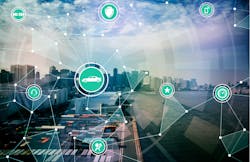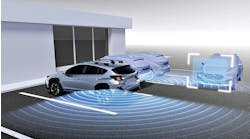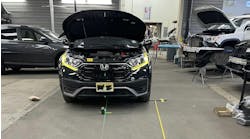As advanced driver-assistance systems become more and more prevalent in vehicles, one looming fear is inescapable for the collision repair industry: Autonomous vehicles could very well eliminate crashes.
An industry also in high water? Insurers.
In fact, it’s already time for insurance companies to be in panic mode, says Jerry Albright. Just in March, State Farm’s annual profit fell 94 percent on car insurance claims costs, and the underwriting loss from auto insurance widened to $7 billion from $4.4 billion in 2016.
Albright, a principal for KPMG, a global network of professional firms providing audit, tax and advisory services, wrote all about it in a recent report he co-authored entitled, “The chaotic middle: The autonomous vehicle and disruption in automobile insurance.” Autonomous vehicle technology could shrink the auto insurance sector by 71 percent—or $137 billion—by 2050, according to the report.
Meaning, if insurance companies want to remain relevant, they’ll need to partner with OEMs, Albright says. And, as access to OEM vehicle data improves and telematics technology becomes more commonplace, those partnerships are ready to form.
In fact, CCC Information Services is pushing for that OEM-insurance partnership with CCC Drive, which is a telematics platform that allows a vehicle to automatically notify an insurer when a crash occurs—and helps the underwriter determine what happens next. As vehicle technology advances and CCC Drive gains popularity, it could have a profound impact on claims, vehicle repair and the entire automotive lifecycle, says Marc Fredman, senior vice president of corporate strategy and development for CCC.
The OEM-Insurance Partnership
As advanced driver-assist systems (ADAS) take over and OEMs retain complete control over their vehicle data, automakers could assume the driving risk and associated liability like insurance companies have, Albright says. By 2050, his report states products liability insurance will cover 57 percent of total auto losses to cover the autonomous technology in vehicles.
Which is where the partnership between OEMs and insurance companies comes in. Insurers already have the infrastructure to work with collision repair shops, and they plan on appeasing OEMs and adapting that process as vehicle technology advances.
This would, in turn, change the claims process, Fredman says.
“With the right permissions, carriers can use telematics data to identify collisions at the point of impact, and then take immediate action to deliver on-the-scene services such as police, emergency responders, or towing,” Fredman says. “That data can then also be shared with the consumer’s chosen repairer to initiate and enhance the repair process, turning a process that today takes days or weeks into potentially seconds.”
And that’s why CCC Drive was developed.
Embracing Telematics
In 2015, CCC acquired DriveFactor, a recognized leader in insurance telematics with clients around the world. DriveFactor’s technology platform was purpose built for processing and analyzing the massive amounts of data generated by telematics-enabled vehicles.
“The plan was to create the industry’s only future-proof telematics platform that could deliver on a broad range of telematics use cases for insurers, shops, OEMs and a variety of third-party services providers,” Fredman says.
Essentially, CCC is offering three different capabilities with Drive: an open, hyperscale platform; an established, growing network; and a stream of telematics data complemented by a comprehensive warehouse of claims and repair information in the industry.
“This combination allows any of our customers to connect once to CCC and have access to 350 insurers, 24,000 shops, numerous OEMs, hundreds of parts suppliers, and dozens of third-party services providers, with the analytics and performance to meet their individual business objectives,” Fredman says.
Insurers, specifically, can leverage the platform, network and data to holistically manage all of their telematics initiatives, enabling them to offer policy services such as usage-based insurance and dramatically streamline the claims and repair process.
The Steering Concerns
The fear that insurance companies will steer drivers to specific collision repair shops is, today, a huge industry concern—and that concern could only grows as insurers embrace telematics.
Fredman recognizes this, but says that, ultimately, as drivers become more acquainted with vehicle technology and telematics becomes the norm, they will choose which vehicle they want to purchase, who will insure that vehicle, and which shop will conduct the repair work.
“Consumers will choose who they want to do business with, and our role is to facilitate the flow of information across all of the various participants involved to deliver the best possible experience for that individual,” he says.
Fredman argues that insurers being connected to a platform that includes telematics and connected car data offers many benefits to collision repairers. For example, when a repair determination is made using telematics data, information can be shared with the appropriate shop sooner, allowing repair scheduling to occur earlier in the process, and perhaps even allowing the shop to order the needed parts before the vehicle arrives.
“The shop can also use telematics data from before, during and after the accident to help them complete a faster, safer, and more efficient repair once the vehicle arrives at the shop,” he says. “Our goal is to future proof shops by integrating this kind of functionality into CCC ONE.”



